Gordon Myers
Articles on Life, Truth, Love, Computers, and Music
The Cross: Finding Balance
This is the last post in my three-part mini-series on the cross. In my first post I talked about how it is necessary to express the "horizontal" aspect of the cross by staying connected with the people around you. Then in my last post I talked about how it is equally necessary to express the "vertical" aspect of the cross by spending alone time with God each and every day, cultivating a deeper sense of spirituality. Today I want to talk about how it is important to keep these two dimensions in balance with each other.
What does an out of balance cross look like? On the one hand, someone who has neglected the horizontal aspect will probably look like a bit of a recluse, whether they acknowledge that or not. They might cultivate two different identities: the face they can put on around church friends, and the face they can put on around everyone else. I feel like this has described me on more than one occassion! So I don't mean to point fingers by writing this, but I do mean to stimulate a healthy sense of self-examination.
Jesus did not cultivate his own deeper sense of spirituality and oneness with the Father only to hide it behind closed doors and keep it to himself. Nor did St. Paul wait until he had all of his ducks lined up in a row before he started boldly preaching the gospel and healing others. Christianity exists to be a positive influence in the world, to make waves in an ocean of suffering and selfishness. Mary Baker Eddy, the founder of my church, once wrote, "sea captains on shore are of no use." Too much focus on the transcendental without the balance of the human side of things can breed self-righteousness and hypocrisy, or it can just be a mask to hide our own fears of actually living the things we like to talk about.
Stepping out of ones comfort zone is never easy. Jesus said, "Whenever a woman is in labor she has pain, because her hour has come; but when she gives birth to the child, she no longer remembers the anguish because of the joy that a child has been born into the world." The newborn child that he speaks of there is a great metaphor for your own life purpose. The downward tendencies of the world would try to miscarry your life purpose. But we each have to rouse ourselves from the sleepy or frightened tendencies to hide away from the world. We need to get out there and shine. Just this morning a friend asked me, "are you being an influence in the world, or are you letting the world influence you?" This is a question we should all be asking ourselves every day. And in order to be an influence for others, you actually have to talk to them.
On the flip side, the cross might also be out of balance if someone has neglected the vertical. That kind of individual goes with the flow and is more interested in "keeping the peace" than making waves that might offend somebody (unless those waves try to justify a pet sin). Jesus gave two great commandments: to love God supremely, and to love others as we love ourselves. But the order of those two commandments matters! We need to put God first, before people. When we're more interested in pleasing others (or ourselves) than we are pleasing God, this also diminishes our own life purpose - or confuses it. That could include idolizing someone as a source of happiness, like a lover for instance. Or it could mean idolizing someone as a source of unhappiness, like a hated politician.
A neglect of the "divinity" aspect of the cross also tends to shut down our natural, childlike willingness to be corrected. It shuts off healthy self-examination and stifles our spiritual progress, defending this stagnation in the name of "compassion." Mary Baker Eddy also wrote, "One thing all must do - watch, and if anything looks like leaning away from God, drop it instantly." How willing are we to let go, instantly, of anything that would hinder our own progress, whether that's a questionable relationship, or another drink, or even long-cherished patterns of thinking? I realize that's a tall order. But at the end of the day, are those things really drawing us closer to God? Do they really leave us feeling more fulfilled?
Here are some questions to consider together as we enter this new year and try to find a more balanced sense of the cross:
- Do I have two identities, or one? Do I hide one of them from society?
- Am I afraid of bringing God into the conversation? Why?
- When's the last time I influenced someone in a conversation in a meaningful way?
- What is my life purpose? Does that purpose serve God more than it serves me?
- Who or what am I making gods out of? Who am I making devils out of?
- How much time do I honestly spend in prayer each day? Are my prayers effective?
- Have I actually read the Bible? Do I actually know what it is I claim to believe in?
I challenge you to take each of these questions as they apply to yourself, not as a tool for correcting others. It's not our province to work out someone else's salvation, only our own.
The Cross: Speaking with Authority
Yesterday I wrote the first of three posts about the two-dimensionality of the cross, wherein I addressed the "horizontal" aspect of deliberately staying connected with ones community. Today I want to talk about the "vertical" dimension, sometimes called the transcendental aspect, of the cross. This aspect of the cross represents ones individual relationship with God, illustrated in the imagery of a vertical line going up from earth to heaven.
Jesus instructed his followers that, "when you pray, enter into your closet and lock your door, and pray to your Father who is in secret." That "closet" he spoke of signifies a quiet sanctuary away from the noise and distractions of the world. It signifies cultivating an active sense of peace, communing with the Father. That quiet time doesn't necessarily have to take place at home, alone, at a prescribed and regimented time of day, necessarily. It can happen right in the middle of a loud situation - and I'll give an example of that in a moment. But even though it can take place amid the fast-paced hustle and bustle of the world, the hard truth is that it probably won't take place there unless you first take a lot of time out of your scheulde at home, alone, to commune with God, in preparation.
Christianity is simple, but it is not superficial. I confess that I struggle with this self-discipline that I'm writing about. But I can see what great value there is in disciplining myself to reserve time out of my day to sit quietly and pray. There is Biblical authority behind it. St. Paul taught to "pray without ceasing." St. Peter was miraculously released from prison after his church members had "prayed without ceasing" on his behalf. And there are many instances where Jesus retreated from the crowds into the wilderness, or to a mountaintop (he liked mountains), to be alone and to pray. For all the time that Jesus spent among the people, he also spent remarkable amounts of time alone, silently communing with God.
But as promised, here's an example of a person entering that "prayer closet" right in the midst of a screamingly loud situation. The following is an excerpt from an article in the Christian Science Sentinel.
As I was walking to my bus stop, I heard shouting break through the pre-dawn stillness. I then saw a fellow commuter yelling at the bus driver at the top of his lungs. This bus had not showed up on time the day before, and its absence had evidently caused this man to be late for his job. Both he and I boarded the bus, where he continued loudly to berate the driver and the entire bus system, much to the shock of the other passengers. My first response was compassion for the driver, who had not even been on duty the day before. Then I felt compassion for the commuter, who I happened to know was a professional engineer and was facing family stresses at home.
In reaching out to God for inspiration that would reveal His peace for everyone, I was led to say a few calming words to the commuter. The next few moments were filled with a profound silence. The man's face relaxed, he leaned back into his seat, and the tension on the bus disappeared. Some minutes later, I heard this man quietly utter the same words I had said. He left the bus offering a polite comment to the driver, who in turn replied pleasantly.
Stories like that inspire me. I'm not sure I would have handled the situation as well as he did! But the first question that always comes to mind when I read stories like that is: how did he do that? And how can I do that? I don't believe it's merely a matter of finding the magic words to say; it's something deeper than that. What that article doesn't touch on is all the hours of daily mental preparation, daily prayer, that came before this story ever happened. That part of the story is seldom included by the time articles go to print, but that part of the story is what really counts.
I work in I.T. And as a result, I get to field a lot of I.T.-related questions, both on and off the job. Oftentimes I'm faced with familiar problems, variations on problems I've dealt with before, and so when I'm asked those kind of questions, I already know exactly how to respond. I can speak with authority in those situations. Other times, I am presented with problems I've never seen or thought of before, so I search Google for answers - and pretty reliably, I find them! As I'm searching, I can kind of feign a sense of authority in my voice, which transforms into a true sense of authority when I do find the solution. But once in awhile, I encounter a problem with no apparent solution in sight. When that happens, I have to hunker down and use my knowledge and deductive skills to try and find the answer myself. And any feigned sense of authority has to drop away to the honest admission, "I don't know, but I'm going to try to figure it out."
When Jesus spoke to disease, he spoke with authority. When his disciples similarly spoke (while they were still learning), they often were a bit more reserved, as if they were doing Google searches for the answers and hoping for the best. Jesus expected that they would eventually do the same works he did, and apprenticed them by having them attempt the same kinds of works he was doing. But early on, they sometimes fell flat. The best example of this is from the ninth chapter of Mark, when Jesus healed the epileptic boy. The father of this epileptic child had asked the disciples if they would heal his son, and they tried! But despite their best efforts, they failed. So then this desperate father turned to Jesus, hoping that Jesus would have the answer, which of course he did. Afterwards the disciples asked Jesus why they weren't able to do it, and Jesus explained the situation to them, speaking as though he knew exactly what the problem was that the disciples weren't yet able to perceive. Jesus' knowledge of what was really going on beneath the surface allowed him to cut through the disease and get right down to healing the young boy, while the disciples were simply doing their best to Google for answers, in a sense, and this was a case where there weren't any easy answers to be found.
People crave real solutions. When the father of the epileptic boy saw that the disciples weren't able to answer his cry for help, he went to their boss, who immediately spoke to him with authority. People crave that kind of authority, which is able to command the situation rather than scrambling for answers without any certainty of success. Jesus promised that his followers would be able to do all the things he could do, and indeed handle other situations that he hadn't faced, when he said, "greater works than these shall [you] do; because I go unto my Father." We also need to "go unto our Father" if we want expect to follow in his footsteps, meaning we need to make room for God in our lives. That means setting aside chunks of time during the day for silent prayer, going to church regularly, and setting aside time (outside of prayer time!) to study the Scriptures. Quiet and consistent preparation is key to being able to handle the challenges that come up in our daily lives - both expected and unexpected. In today's caffeinated, multi-tasking, constantly distracted world, it can be difficult to maintain the discipline to consistently make God a priority. Belive me, I know!
That is the vertical dimension of the cross, and it is requisite for Christian discipleship. Without that dimension, there is no authority behind what we say. We end up speaking either in clichéd platitudes, or in vague and empty promises. It is the quiet time spent alone with God where we really learn how to speak with authority, and how to bring an active sense of peace to situations. Without that genuine committment, we end up throwing darts at a board, smattering people with our uninformed best efforts, while we Google for answers. To truly follow Christ, we need to "leave all for Christ." And that starts gradually, by "leaving some for Christ" - giving at least part of our day to honest prayer.
The Cross: Staying Connected
This post will be the first of a three-part mini-series on the Cross as a symbol of faith. Ever since I first heard a talk about it this summer at the Midwest Bible Conference, I've been stewing over this idea of the symbol of the cross expressed in our lives. By that I am referring to the fact that the cross has both a "vertical" dimension and a "horizontal" dimension to it. The vertical is sometimes called the transcendental, and represents our individual relationship to God. The horizontal, or human dimension, represents our relationship with our community, and indeed with all of humanity. Both dimensions need to be deliberate and need to be in balance with each other, and there is no promise that will always be easy or comfortable.
In this post I want to focus specifically on the horizontal dimension of staying connected with others. Why is it important for us to connect with others? Others can be discouraging and sometimes outright mean. And often there seem to be invisible social barriers that prevent us from truly fitting in with certain social groups. No matter how we try, it seems like there just isn't room for us. So why try at all? Why not just hide away and cultivate a sense of peace for ourselves?
These are questions I've had on my mind for awhile. I confess that, as an introverted person by nature, it's quite easy to just want to squirrel away and insulate myself from the world. But I've been learning, sometimes slowly, of the necessity of family, of community, and of fellowship and communion with others. Jesus said, "For where two or three are gathered together in my name, there am I in the midst of them." He never promised that the spirit of Christ would be witnessed alone in a vacuum. The operative words there are "two" and "three," signifying community.
Just last night, upon arriving home from work, I had a lot I wanted to get done. I know how to keep myself busy; I make checklists of tasks that I need to accomplish. But then I remembered a Christmas hymn sing taking place downtown, at another church I don't belong to, but that I was invited to attend. This presented a dilemma, because taking the time to drive all the way downtown would mean I wouldn't be getting my individual task list done that night. So I had a mini-debate in my mind whether I should go.
"I could get so much accomplished if I stayed home."
"I can accomplish those same things this weekend."
"Will I really accomplish those things this weekend?"
"Friendship is important."
I went back and forth for a little while. But then I started to analyze how much my "Marthan" task list was really just an excuse to avoid being social. And I realized, it was! And as I was already thinking about this topic of the cross, I eventually acknowledged how important it was that I go, even if that meant none of my task list would be accomplished last night.
I'm sure glad I did go. The hymn sing was gorgeous. I am not a very strong singer myself, but just being in the presence of so many voices coming together in unison has a power behind it. There were many in that room that I would have disagreements with, if I really got down to nitty gritty details of theology. But none of that matters when you come together to worship and praise. Human arguments disappear, at least temporarily, into the peace and goosebump-inducing calm of singing together in a church.
Earlier this summer I was struck by a comment made to a friend of mine. She is someone who is a very hard-working and committed person by nature, someone who is a "giver." She is so often giving to others, and especially to her church, that I worry that sometimes things have felt out of balance for her, like she hasn't been able to receive as much as she's given out. The comment that I overheard made to her, that so struck me was this: "You can let church be a support for you, you know." This resonates with me because so many people often take the approach that it is their own personal responsibility to support their family, their church, and the whole world. And when they inevitably fall short of being able to do that, people sometimes retreat into fear and solitude.
I came across a beautiful article awhile ago, titled Lessons on the dance floor, where this exact sort of thing happened to a young man while at a holiday camp. He felt many compounded fears of rejection and experienced a great deal of discouragement. But even after he retreated, he heard a "still, small voice" calling him back. Perhaps the most beautiful part of the piece is the message this young man heard as an answer to his prayer, a gentle nudging from God telling him, "It's time to dance. Go, go..."
There is much discord in this world that tries to separate us and have us to throw up our hands in defeat. The sting of discouragement impels us to hide away in a hole. And when we're really honest, we realize that sometimes we ourselves have been guilty of isolating or even ostracizing others. But love does not thrive in a vacuum, and I agree that the horizontal dimension of the cross must be deliberate. We need to stay connected with each other if we want to see the spirit of Christ manifest. That sometimes involves overcoming our own fears and excuses to join in the hymn sing or on the dance floor. Other times, that involves being patient and understanding with others lest we become guilty of isolating them. I've found it helpful to remember, particularly when a person seems fixated on something we may not agree with, Jesus' admonition that "he that is not against us is on our part."
At the end of the day, you matter, and others matter too. God loved you enough to create you, and he continues to love you enough to sustain you. And what's true for you is true for others as well. This line, from a poem written by Mary Baker Eddy, sums it up well, I think:
Love wipes your tears all away,
And will lift the shade of gloom,
And for you make radiant room
Midst the glories of one endless day.
Published Religious Articles
My website is still quite new, so it's lacking in content. I thought I'd fill it out a little with a quick post to highlight all of the published articles I've already written elsewhere of a religious nature. Enjoy!
-
Praying for Chardon High School
A perspective on the school shooting in Chardon, Ohio
-
There was a better way
Praying through roadblocks while planning a CSO lecture
-
Don't buy into the "bad boy syndrome"
A focus on ones own purity is more attractive than stereotypes
-
Man up to real manhood
Real manhood is a quality that cannot become obsolete or undervalued
-
Letting Go (en Español) (en Français)
A perspective after a breakup
-
Forgiveness brings healing
Here the title is fairly self-explanatory
-
God's gentle love...soaked me in orange juice!
A perspective on obsessive/ruminating thought
-
Let the Spirit flow
Handling criticism in church from within
-
Digging deeper
A look at different Bible translations
-
Learning to teach
A perspective on teaching Sunday School
Thoughts on Connecticut
The news is inundated with reports about the recent school shooting in Connecticut, where it appears a young man with mental health challenges killed many innocent children, some school faculty, and himself. The president gave a speech yesterday, and had to pause in the middle of it because he started to tear up. I thought his remarks were helpful, encouraging, and I particularly loved that he closed by quoting Scripture.
Simply, there is no answer to the question, "Why?", and so I will not attempt to talk about the "why" behind this. But I would like to write today about what we can do. These sorts of situations leave people feeling helpless, powerless, and afraid. I do not believe that more fear is the antidote needed in our lives. So rather than echoing the fears that are justifiably being cried across the country, I want to share a few ideas that I find helpful, beginning with an incident where a "school shooting" in New Hampshire was successfully averted.
I am a member of the First Church of Christ, Scientist. I believe in one God, and Jesus as the promised Messiah. My church was founded in the late 1800s by a woman, Mary Baker Eddy, who herself was a devout follower of Christ Jesus. The following is an excerpt from a biography titled The Life of Mary Baker Eddy by Sibyl Wilbur, first published in 1907, and describes an incident when she was little more than 20 years old, the same age as the man responsible for the tragedy yesterday.
While Mary was attending the academy an incident occurred which was long related by old residents of Tilton[, New Hampshire]. A lunatic, escaped from the asylum at Concord, invaded the school yard, brandishing a club and terrifying the students who ran shrieking into the house. Mary Baker advanced toward him, and the pupils, peering through the windows, saw him wield the club above her head. Their blood tingled with horror for they expected her to be struck down before their eyes. Not so. She walked straight up to the man and took his disengaged hand. At her request he walked with her to the gate and so, docilely, away. On the following Sunday he reappeared and quietly entered the church. He walked to the Baker pew and stood beside Mary during the hymn singing. Afterwards he allowed himself to be taken in charge without resistance.
This story, from the 1840s, had a very different ending than the one we read about yesterday. They both involved young men with mental health challenges carrying weapons into a school full of many young children. But this story from the 1840s ended with the man voluntarily turning himself before any harm was done. I think everyone can agree that that is the best resolution to these kind of stories. The reason I believe that story had such a powerful turnaround to it was not because of any special person involved, but because of the power of God's love, and a fearless obedience to the teachings of Christ Jesus. More on that in a moment. Next, I also want to share a short, one-minute video clip. This scene took place in a courtroom in 2003.
This scene shows part of the trial of Gary Ridgway, known as the "Green River Killer," a serial killer who confessed to killing 71 young women over the course of two decades. This clip shows Mr. Rule, the father of one of the young victims, speaking to Mr. Ridgway with, remarkably, nothing but unconditional forgiveness, despite the fact that the man he is forgiving murdered his own daughter. The full video goes onto say that, while Mr. Ridgway had seemed emotionless and unaffected by everything else that happened in the trial, especially of his rightful condemnation by the victims' families, he was clearly and visibly affected by this man's miraculous sense of forgiveness. Indeed, shortly after hearing these words of forgiveness, Mr. Ridgway - for the first time - confessed to the murders, tearfully. The thing that most struck me in Mr. Rule's comments was when he said "what God says to do is to forgive." Again, here is another instance of a tranformation made possible by fearless obedience to Christ's commands. Lastly, I am also reminded of a famous quotation from the Reverend Dr. Martin Luther King, Jr., where he said this:
Darkness cannot drive out darkness; only light can do that. Hate cannot drive out hate; only love can do that.
There are many discussions that are taking place and will continue to take place about the recent school shooting - about how to prevent this kind of thing in the future. People will talk about gun control laws, metal detectors in schools, mental health warning signs, and so on. Whatever solutions we come to, I think the most important question, a question that searches deeper than any metal detector ever could, is what motivates our actions? Are we motivated by fear? By a desire to live in a bubble? Or by ostracizing all those who seem scary? Or rather, can we be motivated by the same kind of unconditional love that we see in these examples? These examples prove the power of that kind of fearless love.
I do not believe that the dark shadows of fear, hatred, and ostracization can do very much to calm or comfort people - least of all those already "at risk" with mental health challenges. But the unconditional, agape love that Christ taught and demonstrated does transform lives and characters. That kind of love motivates people to stop short of committing heinous acts in the first place, and motivates people to take responsibility for their own actions. This is the kind of brotherly love that forgives in the face of the worst hardship and pain, the kind of sisterly love that offers to hold someone's hand and makes a stand for the best in them even when they seem most scary or out of place. This is the kind of Love that recognizes the unity of all mankind, as Malachi puts it: "Have we not all one father? hath not one God created us?" Jesus himself is perhaps the greatest example of this kind of Love and forgiveness, as he was someone wholly innocent who did not hesitate to forgive those attacking him right in the midst of the pain. That forgiveness transformed the world.
As for the innocent children lost, I refuse to believe that God has, even for an instant, stopped cherishing them, nurturing them, protecting them, and holding them dear, as the "apple of His eye, under the shadow of His wings." I believe that the light of those dear children's lives continues to shine brightly in the Kingdom, and that nothing can ever extinguish that light. As St. Paul puts it, "I have become absolutely convinced that neither death nor life, neither messenger of Heaven nor monarch of earth, neither what happens today nor what may happen tomorrow, neither a power from on high nor a power from below, nor anything else in God's whole world has any power to separate us from the love of God." That beautiful and innocent light may have been obscured from view for most of us yesterday, but as Jesus promised that "the kingdom of God is within you," I know that those children live on, eternally, within all of our hearts, and within the mind of almighty God, where they are forever kept safe, joyful, and free.
The Ten-Egg Challenge: Part 10
Dawn of
The Final Day
-1 Egg Remains-
Day 10: Three-Egg Omelette
I was saving the omelette for last because I consider it to be the hardest. I'd never cooked an omelette before, and while it's fundamentally the same as scrambled in terms of ingredients, I knew that it was all about technique. Originally when I set out to do this challenge, I debated whether I wanted to make it a "dozen egg" challenge, but decided on ten. But the fact that today's challenge requires the use of three eggs instead of one, that does mean that if you have been challenging yourself at home, you should need exactly 12 eggs to complete this challenge, no more and no less. If you've been following along closely, you'll know that I've already gone over that as I hit a few bumps in the road trying to cook over medium. And today... I hit a few more. But as for the numbers, let's face it: you can't really make an omelette with just one egg. Even two would be pushing it. You really need at least three. And so, the three-egg omelette.

To make an omelette, you will need:
- A frying pan,
- Some butter,
- A spatula,
- A bowl,
- A whisk (or a fork),
- Some milk,
- Three eggs, and
- Ingredients of your choosing (I used mozzarella cheese)
Cover the pan with copious amounts of butter (and it is important that it is a non-stick pan!), and set the burner to a medium heat. Crack your eggs into a bowl, drop in a little bit of milk in there as well (1 tablespoon or less per egg), and whisk everything until it is a consistent color throughout. Once the butter is all melted and evenly distributed, pour out your egg milkxture into the pan, and wait. As you wait, you can check it periodically by slightly tilting the pan at an angle. You will probably see some of the liquid fall into whatever direction you tilted it while it is still cooking. Quickly tilt the pan back to being level again. When the liquid has really minimized, so that there isn't much left of it at all, then add your ingredients.

I decided I was going to attempt this omelette in the French style - aka a trifold omelette. The alternative is the American style (a bifold omelette), but I figured the French style would be fancier and more difficult to pull off. I was right. So much so, in fact, that I did a miserable job with it. More on that in a second. To cook an omelette the French style, you'll want to make sure you lay out your ingredients (in my case it was just cheese) in a straight line right down the center. Placement matters with the French style. Placement doesn't matter at all, however, with the American style; then you can just throw the ingredients wherever you like, since it will be flipped over on itself anyway. But for the French style, let it cook about another 45 seconds to a minute (making sure all the liquid is gone), then take your spatula and pull one third of it over the center, and then the other third of it (on the opposite side) right over that. Then grab the whole thing, and flip the whole thing over onto your serving plates, so that the two pieces you flipped over the center are now facing down.

I've strategically chosen the pictures to showcase on this post, because they are the ones that are zoomed in close enough so that it's not obvious that I did a terrible job with this omelette. But rest assured, I did a terrible job with this omelette. I need more practice. I actually ended up making two 3-egg omelettes tonight. The first one I did on a pan that was not a non-stick pan, which was a mistake. The second one I did in a smaller pan, but when it came time to do the flipping, I just didn't have control of the thing with the spatula, and I ended up turning the bottom half of the thing into a goopy mess (which is why I only showed the top piece). As you can see from the last photo, it was still nice and fluffy, so the flavor was at least satisfying. But my technique needs some work. This was only 1-star kitchen material at best.
For some reason, even though the chemical makeup is exactly the same as scrambled eggs, I still prefer scrambled eggs over omelettes. Then again, if someone with actual talent was doing this, and with the right combination of ingredients, perhaps that could change my mind. I don't know. Normally I would have attempted this again and again, until I got it right, but because of some dental work I'm having done tomorrow morning, I have strict instructions not to eat anything after midnight tonight. So... my Ten-Egg Challenge has to come to close in a somewhat unsatisfying way, with a poorly constructed omelette. But this won't be the last time I ever make eggs, so I will have further opportunties to perfect my own abilities. Overall, though, I must say that I am grateful I took on this challenge, as I feel much more prepared in the kitchen now, plus I've picked up some new favorite breakfast dishes! I'd strongly encourage anyone who's curious and motivated to try the whole challenge for themselves.
And now I'll go back through and rank everything on a scale of 1 to 10. I'm also going to give myself the requirement that I only use each number between 1 and 10 once, so that the ratings are actually useful to you. I'm giving the omelette a somewhat harsh 3 out of 10, but I fully admit that may be biased just because I'm still pretty bad at making them.
The Ten-Egg Challenge: Part 9
Day 9: Eggs in a Basket
I couldn't make up my mind for what style of egg I wanted to cook for the penultimate day of the Ten-Egg challenge. I went back and forth for awhile; I considered doing a basted egg, a medium boiled egg, and even a shirred egg, but finally decided on eggs in a basket. Basting an egg isn't really so much a unique type as it is just a different style of cooking sunny side up eggs. Medium boiled is really still a soft-boiled egg at heart, only chunkier. And a shirred egg isn't something you'd ever order at any breakfast place; it more resembles cooking a casserole than making breakfast. But eggs in a basket is a fairly popular style, and even though the egg part of it only comprises half of the ingredients, it is still an egg at heart.
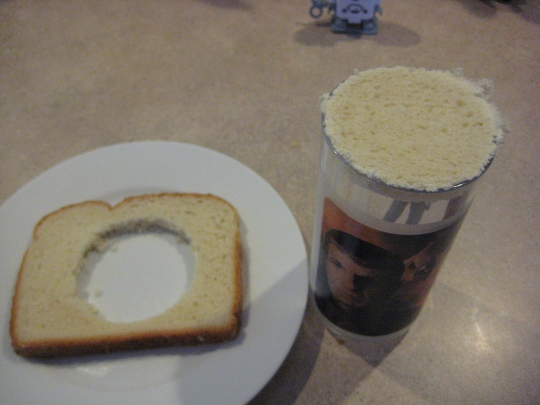
To make eggs in a basket, you will need:
- A slice of bread,
- A cup,
- Lots of butter,
- A frying pan,
- A spatula, and
- An egg
Begin by greasing the pan with copious amounts of butter, and setting the burner to a medium heat. Keep in mind that you will actually have to add in more butter as the process continues. Take the cup and use it to cut a hole out of the middle of your slice of bread. I considered doing shapes more creative than just a plain old circle, like a star or a silhouette of godzilla, but since this was my first time ever making eggs in a basket, I decided it'd be better to just focus on the flavor than the flair - this time around. (By the way, as you can see from the picture above, I actually used one of my Star Trek glasses as my "cookie cutter." I won a set of these glasses for winning the weekly football pool at my office.) Once the butter has melted, drop your piece of bread in the pan (this is called the "basket"), and also drop the cut-out piece of bread in the pan, too, but not in its original hole. This piece is called the "hat." Then crack an egg into the hole in the basket, and wait.
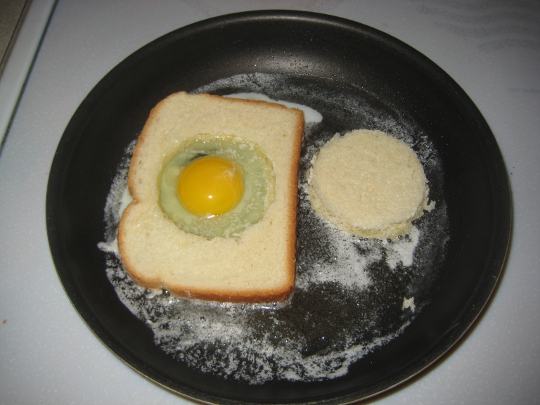
After about a minute or so, when the egg whites have fully solidified, take your spatula and give the whole thing a flip. Also flip the hat. At this point, drop a few globs of fresh butter into the pan, and spread everything around so that the bread absorbs the butter on both sides. You'll find that flipping this is actually a lot easier than flipping a regular egg on its on. The reason is because the bread already has a firmness to it that's easy to manipulate, and as the egg cooks it latches onto the bread and becomes one with it, much like the parasitic relationship that a male angler fish has with a female.
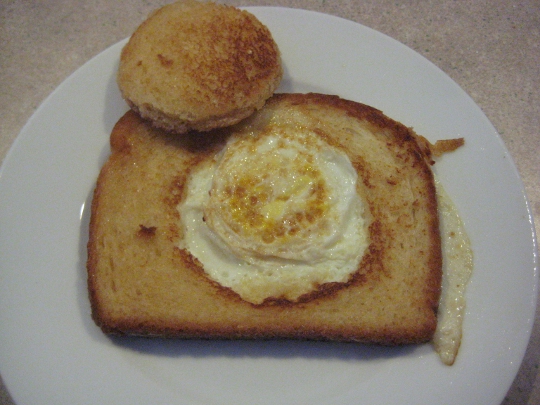
Once it's been flipped, let it cook for another minute or so. You can kind of decide your own timing system here depending on how runny you want the yolk to be. Less time means more runny, more time means more like hard boiled. Then when time's up, use the spatula to flip it back into its original position and onto a serving plate. The egg should hold on tightly to the bread. And you can just place the hat wherever you like. As you can see in the picture, I placed mine askew on the eggtoast's head, as if it were looking up and saying to me, "hats off to you Gordon, why don't you have me for breakfast."
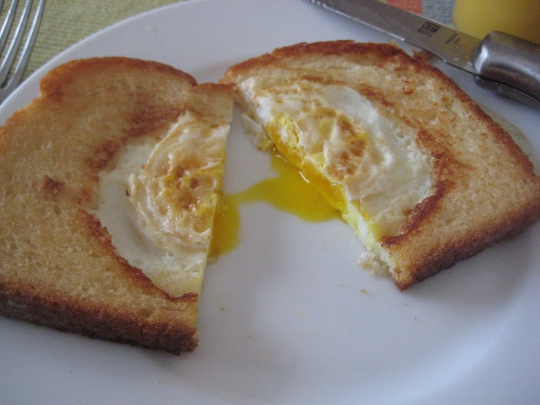
The results? Decent. The bread looks exactly like toast looks, which leads some people to refer to this style as "egg and toast." The texture of the bread is even the same as toast, but the flavor is distinct. It's not toast, strictly speaking; it's fried bread, which does taste a little different than toast. All the many attempts I spent yesterday trying to cook the perfect over medium egg must have finally sunk in, since it just so happened to turn out over medium today with a partially runny yolk. Eggs in a basket get a middle of the road 6 out of 10 from me.
And now I must bid you adieu, dear blog readers, since it is snowing like crazy outside and I'm going to go SLEDDING. :} Check back tomorrow for the final challenge!
The Ten-Egg Challenge: Part 8
Day 8: Over Medium
You may recall that I originally attempted to cook over medium on day 6, but it accidentally turned out as over hard instead. Today I tried again - and again, and again. This morning I woke up, put in 45 minutes on the elliptical machine, took a shower, and then tried to cook myself a breakfast of an over medium egg. Unfortunately, as soon as I sliced it open with a knife, I saw right away that my first attempt was actually an over easy egg. D'oh. So onto take 2. After thoroughly washing everything and starting fresh, I tried again with a second egg. (My egg flipping skills are quite good now, by the way!) The results? Over easy again. D'oh. Not that over easy is wrong - in fact it made for a very tasty breakfast...twice - it's just not what I wanted to do. Finally though, the third time was the charm. This afternoon I tried again and came out with what I will consider to be a successful over medium egg. And regarding my two failed attempts this morning, you know what they say... you can't make an omelette without cracking a few eggs first.
And I'll show myself out.

Here's what you'll need to make an over medium egg:
- A frying pan,
- A spatula,
- Some butter, and
- An egg
This is still the same list of requirements for both over easy and over hard of course. Grease the pan with copious amounts of butter, and heat it up to a medium-high heat. I've given that instruction ("use copious amounts of butter") on a couple of different challenge days now, so in case you were wondering what I mean by that, I've showcased a photo of the pan with butter freshly applied to it above. That's my definition of copious. Of course once the heat gets going it starts to melt and you want to make sure it gets spread over the whole surface of the pan. Then, crack the egg open and wait for about a minute and a half. That will be when the egg whites have fully solidified and then some. Then give 'er a flip! And from there wait exactly one minute, at which point you promptly turn the burner off and transfer the egg onto a serving plate.
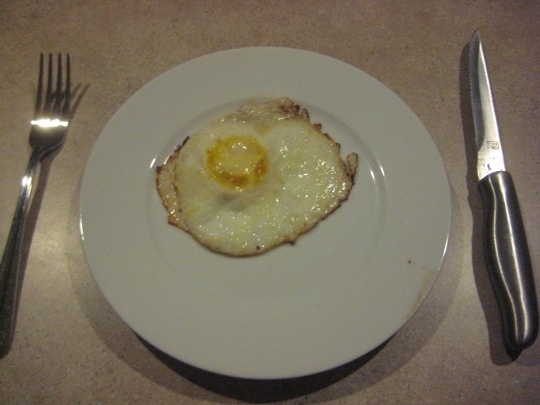
On my first two attempts earlier this morning, I had tried this on a medium heat (which is the same instruction I gave for over hard on day 6). But since both of those turned out under-done, I just decided to crank up the heat on the stovetop to medium-high instead, and thankfully that did it. An over easy egg is all goo in the center; an over hard egg is all fluffy stuff, while an over medium is (not surprisingly) half and half. You'll have some goo, and some cooked yolk too. On day 6, when I cooked the over hard egg, I actually did have a few drops of goo there, too. But, it was so little that I don't think anyone would have taken me seriously had I tried to pass that off as over medium, so it just got designated over hard.

The results? Decent. I think I preferred the two accidental over easy eggs I had for breakfast this morning over the final over medium egg this afternoon, as the closer the yolks get to being hard boiled, the less I like them. The exception of course is with scrambled eggs, but that's probably mostly due to the fact that the egg white is mixed in there as well. With two bad eggs along the way, so far over medium has proved the most challenging. And honestly, I still think I did a pretty poor job. As you can see in some of the pictures, the edges started to brown - which was due entirely to the higher heat. So I think I'll just leave over medium to the professionals, and hope that I don't have a daughter or son one day who picks over medium as their favorite. I give it a 5 out of 10. Other things I learned today: Christmas shopping is expensive! The bill from the post office, for just the Christmas cards plus stamps alone was over $100! I love sharing cards with friends though, so it's all worth it. ![]()
Check back tomorrow for the penultimate egg challenge. Only two days left! What will I cook up next?
The Ten-Egg Challenge: Part 7
Day 7: Soft Boiled
Tonight I had another late start on the egg challenge. I had a pretty full day - getting into work bright and early at 7, followed by a haircut, shopping, and then a nice evening with some church friends. When I finally got home (around 10), I got started on this egg right away. Fundamentally, the idea behind preparing a soft boiled egg is actually quite simple. But this little egg gave me quite a bit of grief. They're traditionally served out of something called an "egg cup" (here's an example) which I learned are remarkably hard to find.
On day 1 of this challenge, I knew that I'd be including this style of egg on the list, so I started looking for them right away. I visited Target and a local dollar store, but could not find them. And since I have about a two-store shopping threshold, I gave up and decided to order one off Amazon instead. I went with the cheapest shipping option, but it still cost more than the egg cup itself. I got an email saying my egg cup had shipped the next day, but I didn't notice until this afternoon that the actual estimated date of arrival isn't until January for some reason. But with only four days left in this challenge (if you include today), I knew I had to find an alternative. So after work today I searched Kohls, Walmart, a local variety store, and then the dollar store again. None of them had egg cups - in fact no one that I asked had ever heard of an "egg cup" before. Fortunately, I found a shallow candle holder at the dollar store that looked like it was just about the perfect size. And indeed it was!
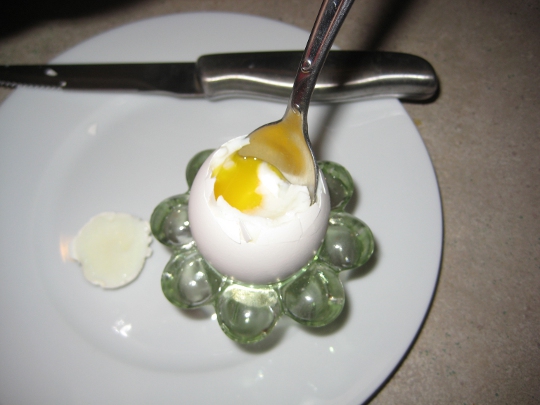
Here's what you'll need to make a soft boiled egg:
- An egg cup,
- A pot of water,
- Some tongs (or a spoon),
- A knife, and
- An egg
Fill the pot with cold water, and make sure it's nice and full so that the egg will be fully submerged when you put it in. Gently put the egg into the cold water right away, and set your stovetop to high so that you can boil the water with the egg in there. Although they say the watchpot never boils, you're going to have to watch it pretty carefully. The timing has to be very precise with a soft boiled egg. Wait too long and you'll have yourself a hard boiled egg. Fail to wait long enough and you'll just have an uncooked egg. Tonight, as I was cooking this, I have to confess that my first attempt was a failed one. I had everything lined up, when I got finished I even set the egg up in my fake egg cup / candle holder and got my digital camera ready to show it off to the world. But alas, instead of cutting it open and finding a soft boiled egg, I wound up with a hard boiled egg. That has been my first real failure on this challenge. (And now I'm going to have to get additional eggs from the grocery store in order to complete this challenge - boo!) But my second attempt turned out perfectly.

When water goes from cold to boiling, it goes through many different phases along the way. One of these phases, which occurs just a few minutes after being put on the stovetop, is that the whole bottom of the pan will be covered with little air bubbles. And what happens next is that those little air bubbles will start to slowly trickle upwards. As soon as it starts doing that - as soon as you see a slow trickle of air bubbles - you'll want to start a timer. I've showcased a picture of what that looks like above. Once you see that slow trickle of bubbles, set your timer for exactly 4 minutes. By the time the 4 minutes is up, the pot of water might not be completely boiling (though it should be close) - and that's okay. Then, at 4 minutes sharp, use the tongs to remove your egg from the boiling water and do one of two things: either (1) run it under a constant stream of cold water, or (2) place it gently in a big bowl of ice water. When I cooked the hard boiled egg on day 5, I used the stream of water. Tonight, I prepared a big bowl of ice water before I started anything else, so I just dropped the egg in there. I only left it in there for about 20 seconds; this cools it to the point where you can comfortably hold it, but the inside will still be nice and warm.
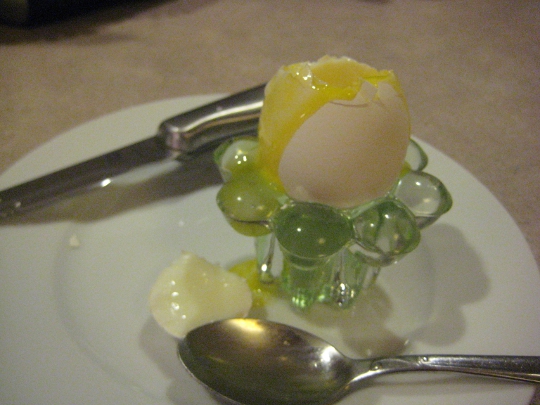
Then, I moved the egg out of the water and into my "egg cup" (which fit surprisingly well!), and took a knife and started tapping towards the top. You basically have to do brain surgery on a soft boiled egg, by surgically removing the top cap and then diving in with your spoon to pull out all the gooey innards. Here's a video of the proper technique. The results? Like I said, the first time I tried this, I was quickly disappointed to learn that I had just made a hard boiled egg. Timing is really key! But on take 2, it turned out beautifully. The yolk was still completely runny, but nice and warm and tasty. You could tell it was cooked, but still liquidy. And it was delicious! I still prefer the fried taste - over easy was pretty darn good - but this wasn't half bad. All the hassle of running around futilely trying to find an egg cup and of having to take a mulligan during cooking eventually paid off in the form of a very tasty egg. So whenever my real egg cup from Amazon does finally arrive, I'll have to make this style again. I'm giving this one a 7 out of 10. Tune in tomorrow (technically speaking today) to see what's next. There are only three styles of eggs left in this challenge!
The Ten-Egg Challenge: Part 6
Day 6: Over Medium Over Hard
Tonight's egg post comes to you much later than usual, because I didn't get home until 9:30 PM! I left straight from work to drive over to the Young Shakespeare Player's Theater on West Lawn Avenue in downtown Madison. They are a remarkable little organization - more on that later. The short and short of it is one of my Sunday School students was performing in their rendition of "Twelfth Night" this evening. So I finally got home just now, and the first thing I wanted was dinner. And the first component of that dinner was this over hard egg.
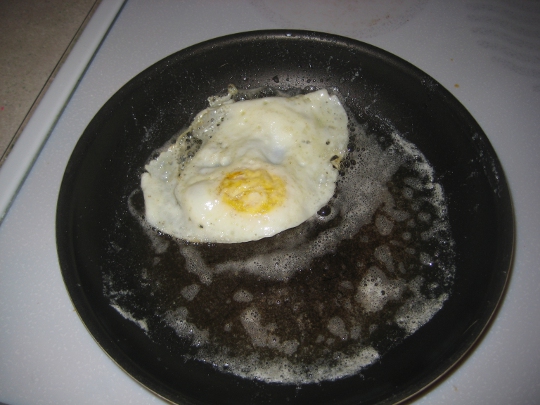
Here's what you'll need to cook an over hard egg:
- A frying pan,
- A spatula,
- Some butter, and
- An egg
Notice that this is the same list of requirements as for Over Easy eggs, since the only ingredient that varies between the two styles is time. The instructions start out just the same: grease the pan with copious amounts of butter, making sure it spreads over the whole surface of the pan, and heat your burner to a medium heat. Then crack the egg in and wait, just as you would with over easy. I said last night that I had come up with an idea to help improve my egg-flipping abilities. I stole a canister of pink Play-Doh from the Sunday School at church last night ("stole" isn't the right word considering I was the one who bought it originally), and molded some of that into the shape of a fried egg. I took an extra pan and dropped my pink fake fried egg in there to practice flipping. I've actually put together a quick video of my attempts, which also includes the final actual egg flip at the end, too.
So continuing on... after the egg has been in there for about two or three minutes (the egg whites should of course be totally opaque), you give it a flip. As you'll see in the video, my egg flipping skills have improved dramatically! My theory is that if you're bad at something, just keep doing it repeatedly until you become good at it. You will. Plus, a little Rocky Balboa music doesn't hurt either. ![]() But back to the egg, you want to wait another two minutes or so, and then take it out of the pan and onto your serving plate. You'll know you've done it right if the yolk is solid, as pictured below. Now I do have a confession to make, which some of you have probably already picked up on from the strike-through lettering above. I had originally intended to cook an over medium egg tonight, but it wound up being over hard instead. But, you know, I was already planning on doing over hard as part of this challenge anyway, so it got moved up to tonight! The reason was I was so distracted thinking about the perfect flip that I left it on the burner longer than I had originally intended.
But back to the egg, you want to wait another two minutes or so, and then take it out of the pan and onto your serving plate. You'll know you've done it right if the yolk is solid, as pictured below. Now I do have a confession to make, which some of you have probably already picked up on from the strike-through lettering above. I had originally intended to cook an over medium egg tonight, but it wound up being over hard instead. But, you know, I was already planning on doing over hard as part of this challenge anyway, so it got moved up to tonight! The reason was I was so distracted thinking about the perfect flip that I left it on the burner longer than I had originally intended.

The results? If an over easy egg and a hard boiled egg had a baby, it would be a really bizarre chicken. And if that went on to lay an egg, it would be this over hard egg. I like the "over easy" part of this egg - the good, fried whites - but I'm not a big fan of the hard yolk. Again, it wasn't bad, per se; it's just not my thing. I'll give it a 4 out of 10. But as for the Shakespeare play I attended, it was INCREDIBLE! That gets a solid 11. I'll be going to that same theater again next week when another church member is taking part in a dramatic reading of Charles Dickens' A Christmas Carol. I had the privilege of seeing that story read, unabridged, in a dramatic style last year, and that was a real treat.
The thing about YSP is that they do everything unabridged. In the case of Dickens' Christmas Carol, that is wonderful. In the case of Shakespeare, well, expect three to four hours minimum per play. But I have to say, I really enjoyed Twelfth Night a lot! I admit I didn't totally know what was going on all the time, but I definitely picked up on the major plot points and all the innuendos. Shakespeare was no shrinking violet when it comes to innuendos. Check back tomorrow to see which kind I'm cooking up next.



